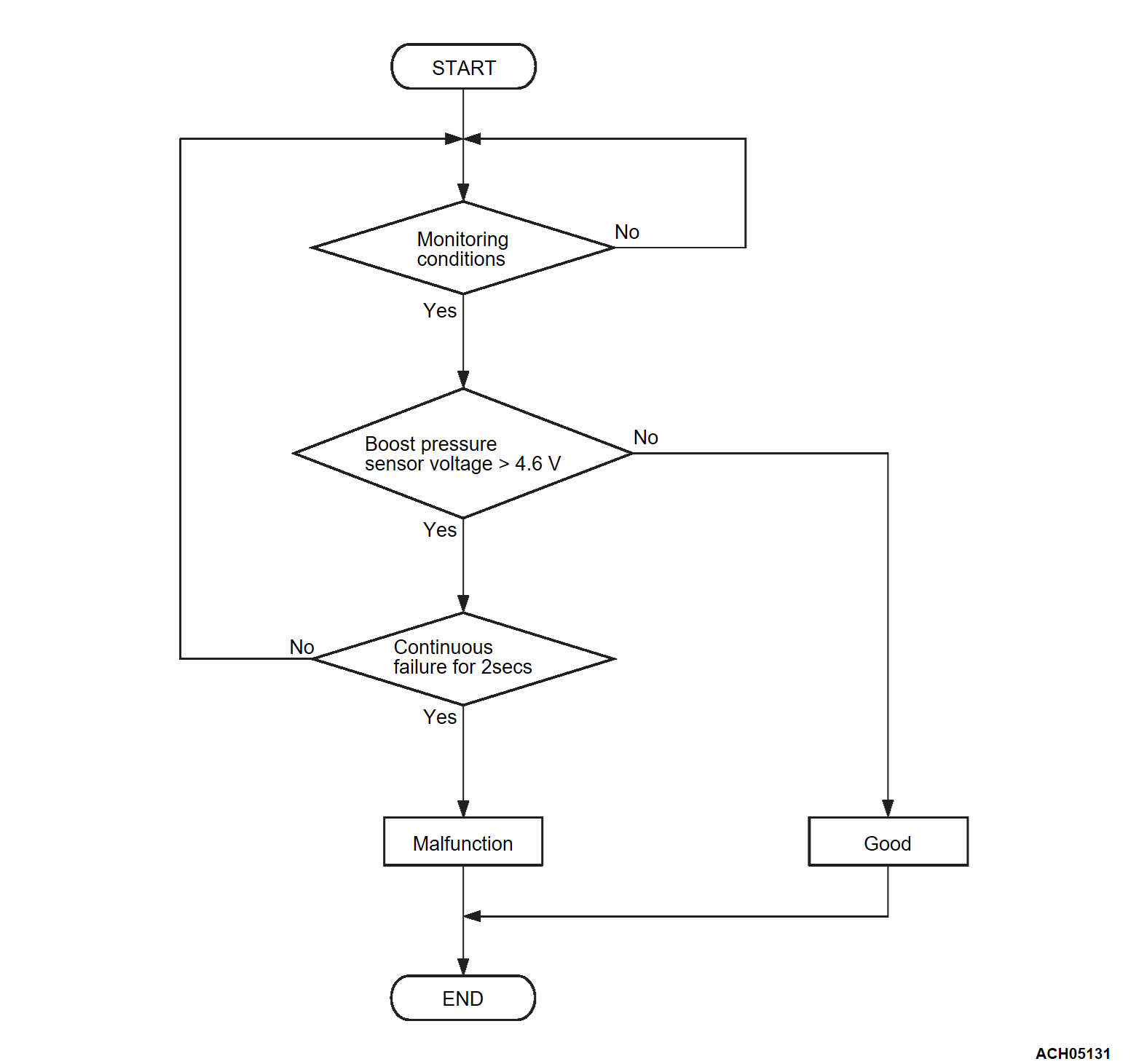DTC P0238: Boost Pressure Circuit High Input
CIRCUIT OPERATION
- A 5-volts voltage is supplied to the boost pressure sensor power terminal from ECM terminal UPS5. The ground terminal is grounded with ECM terminal E.
- A voltage that is proportional to the intake charge pressure is sent to the ECM terminal UPS from the boost pressure sensor output terminal.
TECHNICAL DESCRIPTION
- The boost pressure sensor outputs a voltage which corresponds to the intake charge pressure.
- The ECM checks whether this voltage is within a specified range.
DESCRIPTIONS OF MONITOR METHODS
- Boost pressure sensor output voltage is out of specified range.
MONITOR EXECUTION
- Continuous
MONITOR EXECUTION CONDITIONS (Other monitor and Sensor)
Other Monitor (There is no temporary DTC set in memory for the item monitored below)
- Not applicable
Sensor (The sensor below is determined to be normal)
- Not applicable
DTC SET CONDITIONS
Check Conditions
- 8 minutes or more have passed since the engine starting sequence was completed.
or
- Engine coolant temperature is more than 0°C (32°F).
Judgment Criterion
- Boost pressure sensor output voltage is more than 4.6 volts for 2 seconds.
FAIL-SAFE AND BACKUP FUNCTION
- Intake charge pressure is restricted.
TROUBLESHOOTING HINTS (The most likely causes for this code to be set are:)
- Boost pressure sensor failed.
- Open boost pressure sensor circuit, harness damage or connector damage.
- ECM failed.
DIAGNOSIS
STEP 1. Using scan tool (M.U.T.-IIISE), check data list item 125: Boost Pressure Sensor.
| caution | To prevent damage to scan tool (M.U.T.-IIISE), always turn the ignition switch to the "LOCK" (OFF) position before connecting or disconnecting scan tool (M.U.T.-IIISE). |
(2) Turn the ignition switch to the "ON" position.
(3) Set scan tool (M.U.T.-IIISE) to the data reading mode for item 125, Boost Pressure Sensor.
- When altitude is 0 m (0 foot), 101 kPa (29.8 in.Hg).
- When altitude is 600 m (1,969 feet), 95 kPa (28.1 in.Hg).
- When altitude is 1,200 m (3,937 feet), 88 kPa (26.0 in.Hg).
- When altitude is 1,800 m (5,906 feet), 81 kPa (23.9 in.Hg).
(4) Start the engine.
- When the engine is idling, 70 - 110 kPa (20.7 - 32.4 in.Hg) (Near the atmospheric).
- When the engine is suddenly revved, intake charge pressure varies.
(5) Turn the ignition switch to the "LOCK" (OFF) position.
Is the sensor operating properly?
STEP 2. Measure the resistance at boost pressure sensor connector.
(1) Disconnect the connector and measure at the harness side.
(2) Measure the resistance between terminal E line and ground.
- Continuity (2 ohms or less)
Does continuity exist?
STEP 3. Check of open circuit and harness damage in E line between boost pressure sensor connector and ECM connector.
Is the harness wire in good condition?
STEP 4. Using scan tool (M.U.T.-IIISE), check data list item 125: Boost Pressure Sensor.
(1) Turn the ignition switch to the "ON" position.
(2) Set scan tool (M.U.T.-IIISE) to the data reading mode for item 125, Boost Pressure Sensor.
- When altitude is 0 m (0 foot), 101 kPa (29.8 in.Hg).
- When altitude is 600 m (1,969 feet), 95 kPa (28.1 in.Hg).
- When altitude is 1,200 m (3,937 feet), 88 kPa (26.0 in.Hg).
- When altitude is 1,800 m (5,906 feet), 81 kPa (23.9 in.Hg).
(3) Start the engine.
- When the engine is idling, 70 - 110 kPa (20.7 - 32.4 in.Hg) (Near the atmospheric).
- When the engine is suddenly revved, intake charge pressure.
(4) Turn the ignition switch to the "LOCK" (OFF) position.
Is the sensor operating properly?
STEP 5. Using scan tool (M.U.T.-IIISE), check data list item 125: Boost Pressure Sensor.
(1) Turn the ignition switch to the "ON" position.
(2) Set scan tool (M.U.T.-IIISE) to the data reading mode for item 125: Boost Pressure Sensor.
- When altitude is 0 m (0 foot), 101 kPa (29.8 in.Hg).
- When altitude is 600 m (1,969 feet), 95 kPa (28.1 in.Hg).
- When altitude is 1,200 m (3,937 feet), 88 kPa (26.0 in.Hg).
- When altitude is 1,800 m (5,906 feet), 81 kPa (23.9 in.Hg).
(3) Start the engine.
- When the engine is idling, 70 - 110 kPa (20.7 - 32.4 in.Hg) (Near the atmospheric).
- When the engine is suddenly revved, intake charge pressure.
(4) Turn the ignition switch to the "LOCK" (OFF) position.
Is the sensor operating properly?
![[Previous]](../../../buttons/fprev.png)
![[Next]](../../../buttons/fnext.png)



